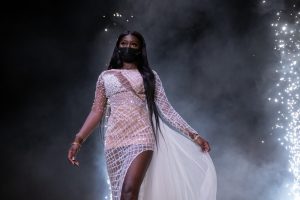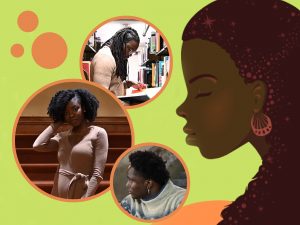Stop acting like Black women can’t afford designer items
Stop acting like Black women can’t afford designer items

In a cherry red, plunging dress, an iced-out Cuban-link necklace and large hoop earrings, the two-time Grammy-nominated rapper Saweetie said on Instagram Live, “If he’s not getting you a Birkin, if he’s not paying your bills, then send that n— back to the streets! Ok?” The Birkin referenced in that statement is the purse named after British actress Jane Birkin and is a wildly expensive and exclusive luxury item from Hermès. It cost anywhere from $40,000 to $500,000. In that social media moment, the songstress was promoting her then new single “Back to The Streets,” a breakup song with a twist about sending “F-boys” exactly where they belong — to the street.
What was supposed to be a lighthearted, humorous comment about women being spoiled in romantic relationships quickly turned sour. “I think the Birkin conversation is funny because everyone assumes this is an easily obtainable item and it’s NOT. a lot of y’all fave girlies got fake Birkins,” one commenter wrote on Twitter in response to Saweetie’s clip, receiving more than 2,000 likes. But Saweetie wasn’t the only one caught in the Birkin backlash. In the same month, Grammy Award-winning rapper Cardi B experienced similar blowback after showcasing her 20-plus Birkin bags on Instagram, a collection worth millions. “You can only get so many Birkins a year. They don’t sell Birkins every day so it may be a knock off but it’s still money,” one person wrote under Cardi’s post. The Bronx native just made history with the Recording Industry Association of America recently announcing that she is the first female rapper with three diamond-certified songs, and she quickly silenced haters. “Actually I got four bags from the Hermès store today. Why is it that y’all are asking female rappers if they can get a bag from the Hermès store? Y’all don’t do that to these white celebrities,” she said.
That is a question more and more people are asking — especially people of color and, more specifically, Black women. “It all goes back to anti-Blackness and misogynoir, where people make being a Black woman synonymous with poverty,” said Kenny J. Williams, Jr., a Black pop-culture writer and host at Blavity.
Also weaved into the questioning of Black women’s attainment of luxury items is the idea that Black women don’t deserve designer items because they’re not considered high-value women. “The only difference between these non-Black women and Black women is race. When you put Black women in these roles, it’s like, ‘Oh, wait a minute. You’re not allowed to be here,” said Tiffany Barber, an assistant professor of Africana studies and art history at the University of Delaware.
But, the data proves this racist narrative false. Business of Fashion reported that “Black people are 31% more likely to spend $500 or more on a handbag and 21% more likely to spend the same amount on costume jewelry” according to a 2021 Neilsen study. The reason they spend more is because they possess the means to do so: Black people’s spending power is $1.3 trillion annually and is expected to reach $1.8 trillion by 2024. In addition, as Blavity’s Williams points out, Black women are most often the blueprint for designer trends and the catalyst behind increasing the sales of designer items. In 2017, Cardi B’s hit single “Bodak Yellow” mentioned the popular red sole of designer shoe brand Christian Louboutin, and the lyric “These expensive, these is red bottoms, these is bloody shoes” helped boost the brands’ internet searches by 217% that year, totaling to a $4.5 million dollar profit.
But, the challenges and backlash Black women receive about their luxury items bleed beyond A-list celebrities. With Black finger waves that perfectly mold her face, a million dollar net-worth and 2 million Instagram followers on her blog page, Claire Sulmers, founder and CEO of Black fashion blog Fashion Bomb Daily still experience adversity in the luxury space.
Growing up in Stone Mountain, Georgia, Sulmers attended junior high with mostly rich white kids who wore designer clothes like they were retail. At one point, Sulmers’ family faced economic setbacks, which affected her access to designer clothes. “There was a moment in my youth when my dad was laid off and my mom wasn’t working. They couldn’t afford the labels. But my dad bought me a couple of T-shirts from the Banana Republic, The Limited and some designer jeans,” Sulmers said, laughing and saying she “wore them out.” Sulmers remembers being bullied by one girl in junior high who made her “feel bad about not having lots and lots of options,” often having to repeat outfits.
The pre-teen ridicule pushed Sulmers to be more creative, igniting her talent in fashion and curating legendary looks — designer label or not. “I turned that adversity into opportunity, and eventually became ‘best dressed’ by shopping for sales at the popular stores,” she said. Turning hardship into success or, in this case, a best-dressed award, is a survival tactic ingrained in most Black people, and the Black community has an extensive history related to fashion and the creation of clothes.
Sulmers said that during slavery, enslaved Black people were subjected to picking the cotton used to make clothes in textile mills. This violent, forced labor helped create the fashion industry that exists today and underscores why Black women deserve to purchase luxury items. “Due to Jim Crow, discrimination and all-out violence, for a long time, Black people have been denied financial, social and civil equality,” Sulmers said. “This is the era of the Black Renaissance. A time when all Black people can enjoy the fruits of their ancestors’ labor — literally.” Black women are labeled as “not deserving” of luxury items, even though they have spending power, a history of helping designer brands earn more money and can be connected to the creation of clothes.
Although data proves the falsity of this racist message, to uphold the facade, mainstream media labels Black women as gold diggers and materialistic when they try to surround themselves with luxury experiences. There are countless examples of this negative archetype in history and pop culture. Barber said this stereotypical labeling is a ploy to discourage Black women from desiring luxury experiences, including, but not limited to, designer items. “I think there’s a way that you could trace the development of the gold digger stereotype back to these other problematic stereotypes about Black women and their sexual prowess,” she said. “The Jezebel, the Sapphire, these kinds of things not only become a way to dismiss Black women’s desires but also relegate them to the realm of the undesirable, which then reinforces their kind of structural position at the bottom of the social hierarchy.”
Kristen Bradley, also known as The Chic Maven to her 54,000 YouTube subscribers, said the “gold-digger” trope is a way to gatekeep luxury from Black women. “Luxury purchases are seen as a ‘lifestyle’ for rich white women and just ‘flexing’ for Blacks, even when these Black people can also comfortably afford the items. Why is it not also a lifestyle for them as well?” Bradley said over email. “This has more to do with classism/racism in my opinion.”
The truth is, as much as history is filled with negative stereotypes of poor, materialistic Black women, there is another side: a hidden history of Black people obtaining large amounts of wealth and displaying it through modes of fashion. Taken on the streets of Harlem, New York, in 1932, is a renowned image by Black photographer James Van Der Zee of a rich Black couple. According to New York’s Museum of Modern Art, the couple is dripping in wealth, each of them wearing raccoon fur jackets in front of a Cadillac. This photo isn’t remembered for its rarity but for its beauty. There are countless other photos and moments from history showing Black people’s displays of opulence that are often untold, to discourage them from experiencing luxury.
This isn’t the only problem with luxury designer spaces. Not only are Black women constantly ridiculed for purchasing luxury items, but there are countless examples of haute couture fashion houses culturally appropriating styles, creating one-dimensional racist objects for commercial gain and lacking diversity in runway models. The most treacherous example of this was when Gucci released a look into their Fall Winter 2018 line, featuring a black turtleneck sweater with a long collar that covers the face and a red hole for lips. The sweater, seemingly depicting Blackface, was swiftly removed from the designer brand’s website after complaints. The brand released an official apology statement, saying, “Gucci deeply apologizes for the offense caused by the wool balaclava jumper. We consider diversity to be a fundamental value to be fully upheld, respected, and at the forefront of every decision we make.” The Black community was not only outraged over the sweater’s resemblance to the Blackface minstrel character Sambo but also at the fact that Gucci was audacious enough to try to profit off of the blatantly anti-Black trope.
But, in the last few years, the fashion industry has seemingly improved. Following the murders of Breonna Taylor, George Floyd and Ahmaud Arbery, the onset of the 2020 resurgence of the #BlackLivesMatter movement has influenced popular fashion houses to overtly denounce racism and other forms of discrimination among the BIPOC community. But, with the economic benefits brands stand to gain by empathizing with Black consumers, proof of this support being genuine can only be found in the data. According to reports from The New York Times, “Five out of nine American Vogue covers since September have featured Black models, three of them shot by Black photographers (another featured an illustration of a Black designer), as have four out of six Elle UK covers and three out of six Vogue UK. InStyle used Black models and Black photographers for four out of six issues.” So, there is some change starting to occur in moving the fashion industry toward Black representation.
Ariele Elia, the assistant director at the Fashion Law Institute in New York City, remains optimistic about the future of fashion and believes the industry is actively working towards diversity and inclusion. “Most brands have this incredible opportunity if they include more diversity,” Elia said. “I think we are seeing that in the newest Tiffany & Co. advertisement, featuring Beyoncé and Jay Z. People’s idea is [asking] ‘who is the luxury customer’ and actually showing it in their ad campaign. I think that has changed the conversation a lot.” In the luxury jewelers’ ad campaign, titled ABOUT LOVE, Beyoncé made history as the first Black woman to wear the iconic 128-carat Tiffany Diamond.
Black professionals in the fashion industry are making their own initiatives to drive change, too. Aurora James, the founder and creative director of Brother Vellies, started the Fifteen Percent Pledge, a new initiative where brands are called to commit at least 15% of their shelf space to sell Black-owned business’ products. So far, 28 retailers have accepted the pledge, including Vogue, KITH and InStyle. Similarly, editor-and-chief of The Cut, Lindsay Peoples Wagner and Sandrine Charles, a public relations consultant, created the Black In Fashion Council, an organization that, according to its mission statement, was “founded to represent and secure the advancement of Black individuals in the fashion and beauty industry.”
As for Sulmers, the proof of the fashion industry’s growth is in the work she has accomplished through her blog, Fashion Bomb Daily. So far, Sulmers’ business is soaring with success and tangible industry change. The Harvard graduate created the blog in 2006, and it is now a multilevel fashion powerhouse, with over 2.4 million monthly visitors. It made Ebony magazine’s 2011 “Power 100” list, and Black Enterprise named Sulmers the Black Blogger of the Month in May the same year. Through Fashion Bomb Daily, Sulmers is actively carving out a safe space that amplifies Black designers and gives fashion-forward Black women accessibility in purchasing luxury goods. The site has become the go-to destination for Black women to digest fashion show reviews, celebrity looks for less, Black boutique spotlights, and advice for Black designers on how to thrive in the industry. “The reward for me has and always will be making fashion accessible to the masses, providing a platform for emerging designers, influencers, celebrities, and stylists of color to be seen, and representing Black excellence in fashion,” Sulmers said. As the CEO and founder of the renowned blog, Sulmers is most proud of the progress it has made in starting conversations about real change in racial equity in the fashion industry. “Having an inclusive platform is important,” Sulmers said. “It helps Black women globally see themselves displayed positively and provides inspiration to let them know that anything is possible.”
For so long, Black women were intentionally left out of conversations surrounding vanity, femininity and fashion because the racial hierarchies at play didn’t believe Black women deserved access to these things. Now, Black women not only possess the means to spoil themselves in the luxury space but to contribute as creatives in making the luxury space more inclusive. “Black women deserve to be treated with respect and dignity, and they deserve luxury in all areas of life, whatever that means to them,” Sulmers said. The answer was never about setting strict rules about how luxury should look but, more importantly, highlighting the fact that everyone deserves to indulge in the finer things in life, especially Black women.








